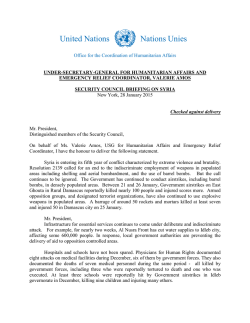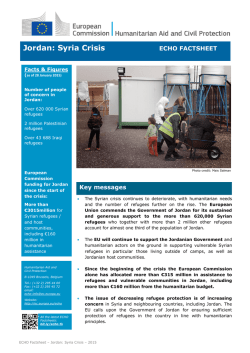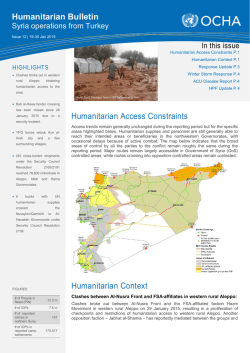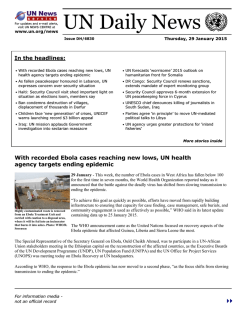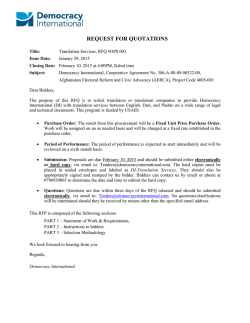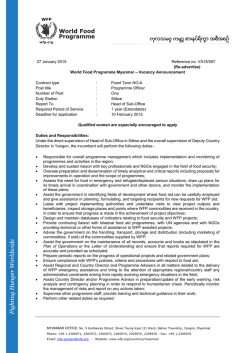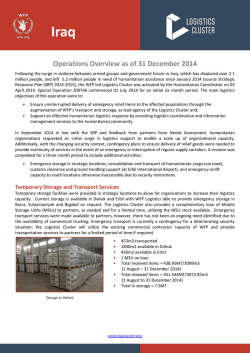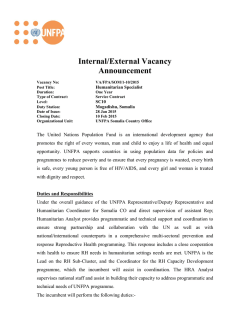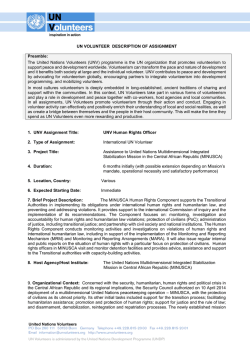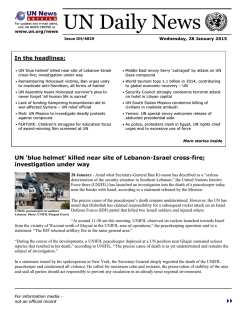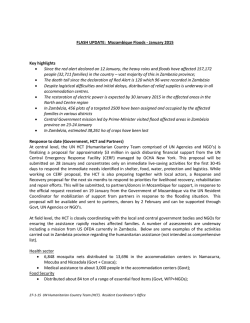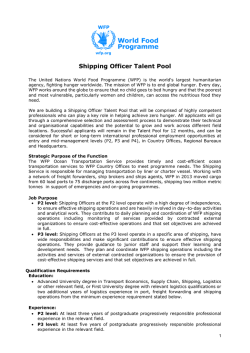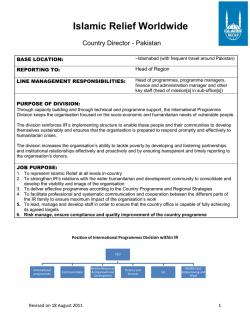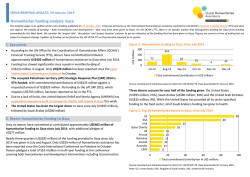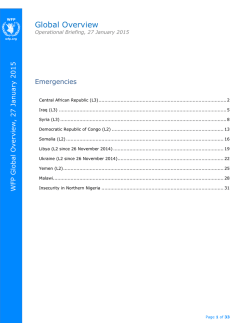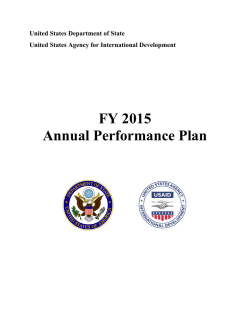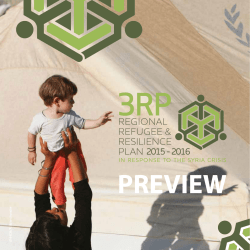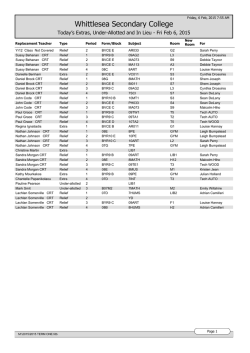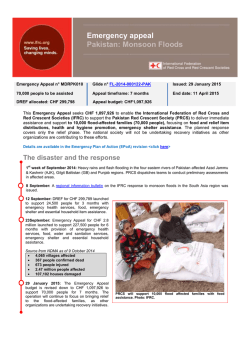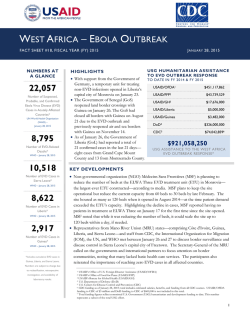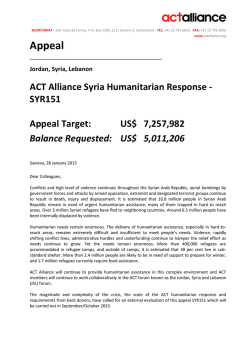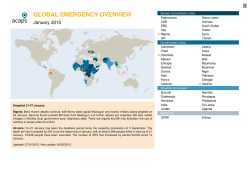
2.7 million - Center for International Disaster Information
CENTRAL A FRICAN R EPUBLIC - COMPLEX E MERGENCY FACT SHEET #8, FISCAL YEAR (FY) 2015 NUMBERS AT A GLANCE 2.7 million USAID/OFDA1 FUNDING 1.5 million Estimated Number of People in CAR Requiring Emergency Food Assistance UN World Food Program (WFP) – December 2014 438,540 Approximate Number of Internally Displaced Persons (IDPs) in CAR Office of the UN High Commissioner for Refugees (UNHCR) – January 2015 51,060 Approximate Number of IDPs in CAR’s Capital City of Bangui UNHCR – January 2015 427,200 Approximate Number of Central African Refugees Displaced to Neighboring Countries HIGHLIGHTS BY SECTOR IN FY 2014 & FY 2015 3% 2% 4% 7% 32% 9% Estimated Number of People in the Central African Republic (CAR) Requiring Humanitarian Assistance UN Office for the Coordination of Humanitarian Affairs (OCHA) – December 2014 F EBRUARY 2, 2015 11% 14% 16% Logistics & Relief Commodities (32%) Health (16%) Water, Sanitation, & Hygiene (14%) Protection (11%) Agriculture & Food Security (9%) Humanitarian Coordination & Information Management (9%) Economic Recovery & Market Systems (4%) Shelter & Settlements (3%) Nutrition (2%) USAID/FFP2 FUNDING BY MODALITY IN FY 2014 & FY 2015 57% Local and Regional Procurement 41% 2% Armed groups kidnap aid workers and a UN Multidimensional Integrated Stabilization Mission in CAR (MINUSCA) staff member An estimated 30,000 CAR refugees flee southern Ouaka Prefecture for northern Democratic Republic of the Congo (DRC) The USAID-funded Famine Early Warning System (FEWS NET) reports continued Crisis and Emergency—IPC 3 and 4—levels of food insecurity* HUMANITARIAN FUNDING TO THE CRISIS IN FY 2014 & FY 2015 USAID/OFDA $40,079,271 USAID/FFP2 $69,000,000 State/PRM3 $70,898,621 $179,977,892 TOTAL USAID AND STATE ASSISTANCE U.S. In-Kind Food Aid Food Vouchers KEY DEVELOPMENTS On January 23, UNHCR and 18 humanitarian partner organizations established the 2015 CAR Regional Refugee Response Plan (RRRP). The RRRP requests $331 million to provide assistance to an estimated 460,000 refugees from CAR in neighboring countries through December 2015. Currently, more than 10 percent of CAR’s entire population of 4.5 million is displaced in Cameroon, Chad, DRC, and the Republic of Congo. The humanitarian community in CAR cautions that the complex emergency has had a significantly detrimental effect on families’ ability to procure sufficient food. Separate assessments and monitoring reports released by WFP, the UN Food and Agriculture Organization (FAO), and FEWS NET indicate that the precariousness of agricultural and livelihoods conditions, coupled with persistent displacement and insecurity, will likely cause prolonged—and potentially deteriorated—food security conditions in the coming months. UNHCR – January 2015 * The Integrated Food Security Phase Classification (IPC) is a standardized tool that aims to classify the severity and magnitude of food insecurity. The IPC scale, which is comparable across countries, ranges from Minimal—IPC I—to Famine—IPC 5. 1 USAID’s Office of U.S. Foreign Disaster Assistance (USAID/OFDA) 2 USAID’s Office of Food for Peace (USAID/FFP) 3 U.S. Department of State’s Bureau of Population, Refugees, and Migration (State/PRM) 1 INSECURITY, DISPLACEMENT, AND HUMANITARIAN ACCESS Kidnappings of aid workers and civilians by armed groups remain commonplace. On January 19, anti-Balaka fighters kidnapped two aid workers—a French woman and a Central African man—travelling by vehicle from Ombella-M'Poko Prefecture’s Damara town to the capital city of Bangui, international media reports. The attackers robbed the driver but allowed him to escape; the fighters commandeered the vehicle with the aid workers still inside. Reports indicate that the attackers drove the vehicle into Bangui’s Boy Rabe neighborhood. In a separate incident on January 20, armed attackers—presumed to be anti-Balaka elements—kidnapped a MINUSCA staff member in Bangui. The assailants released her hours later, the UN reports. On January 20, Principal Humanitarian Coordinator in CAR, a.i., Mohamed Malick Fall appealed for anti-Balaka to immediately and safely release the French aid worker, underscoring that such attacks threaten humanitarian efforts to reach persons in need of relief, media report. On January 24, the French Government announced that anti-Balaka fighters released her; as of January 30, there is no information regarding the remaining hostage. Nearly 30,000 CAR citizens fled Ouaka’s Kouango town to northern DRC’s Bosobolo Territory in December 2014, according to local authorities. The refugees are sheltering in approximately 20 sites along the Oubangui River, which separates the two countries. In response, UNHCR deployed an assessment team to areas along the Oubangui with newly displaced CAR refugees to evaluate humanitarian needs. Based on their findings, UNHCR and partners are developing a shelter plan that relocates these refugees farther from the CAR border where security is better and relief agencies can provide assistance. The Government of CAR (CARG) and international community continue to develop an IDP return strategy for the approximately 20,000 IDPs sheltering at M’Poko International Airport, according to the UN. In recent days, the Ministry of Social and Humanitarian Affairs publicly informed IDPs at M’Poko that the CARG will not forcibly relocate them. Further, the CARG announced that it has created four task forces, each led by a UN partner— alternative site, communication with communities, registration, and return—to manage eventual, voluntary IDP returns from M’Poko to areas of origin. MINUSCA announced the arrest of Rodrigue Ngaibona, head of the anti-Balaka forces, in Ouham Prefecture’s Bouca town on January 19. A MINUSCA contingent transported Ngaibona to Ouham’s Bossangoa town, where Central African authorities took custody of him, according to the UN. Since September 2014, MINUSCA has arrested more than 200 people associated with insecurity in CAR, in collaboration with Central African authorities, the UN reports. FOOD SECURITY The FEWS NET remote monitoring report for January asserts that, given livelihood disruptions, the majority of IDPs in CAR will continue to experience Crisis—IPC 3—levels of food insecurity through June. Due to a deficit in crop output, lack of income, and additional needs associated with displacement, most IPC 3-affected families have depleted their stocks. A smaller portion of households may exhibit Emergency—IPC 4—food insecurity conditions without sustained humanitarian assistance. In December 2014, FEWS NET had reported that between 500,000 and 1 million people were experiencing Crisis—IPC 3—levels of food insecurity. FEWS NET also anticipated that poor families would likely exhaust household stocks prematurely and that the lean season would begin in January—earlier than usual—and extend through March. The UN World Food Program (WFP) released the December 2014 Emergency Food Security Assessment (EFSA) for CAR on January 30. WFP and its partners surveyed nearly 2,200 households across all 16 prefectures between September 13 and 25, 2014. EFSA results indicate that the contributing factors to acute food insecurity persist and/or have intensified in recent months. More than half of all respondents had experienced an income- and household wealth-damaging shock during the previous months. One-third of respondents reported owning livestock; of this group, nearly half reported animal deaths due to illness while more than 30 percent reported that looting, insecurity, and displacement caused them to lose livestock. Limited income-generating opportunities and negative coping strategies— such as removing children from school or engaging in illicit activity—to protect food intake are becoming more 2 commonplace and unlikely to reverse in the near future. Meanwhile, the price of staple goods began increasing substantially in July 2014, further limiting families’ ability to purchase food. In late January, FAO released the findings of the joint FAO–WFP August 2014 Crop and Food Security Assessment Mission to CAR. 2014 was the second consecutive year of reduced agricultural production. The assessment found overall 2014 crop production remained approximately 58 percent lower than the 2008–2012 pre-crisis average; however, 2014 output reflected an 11 percent increase from 2013. Widespread insecurity and erratic rainfall in western areas of CAR during 2014 reduced usable agricultural land by 23 percent, further compromising food access and dietary diversity. These factors caused many populations to resort to negative coping strategies, such as substituting cereals, animal proteins, and vegetables for cassava. WFP and FAO warn that prolonged dietary deterioration increase the risk of malnutrition and associated health consequences. NUTRITION Nutrition partners cared for nearly 26,000 children experiencing severe acute malnutrition (SAM) through in- and outpatient therapeutic programs during 2014, or 93 percent of the total population in need, according to the UN. In addition, USAID/FFP partner WFP reports that, out of the nearly 70,000 individuals admitted to WFP’s targeted supplementary feeding program in 2014, almost 85 percent recovered. To prevent malnutrition, WFP distributed Plumpy’Sup to more than 23,800 children younger than five years of age each month. In early January, OCHA reported projections that, in the coming year, an estimated 32,000 children in CAR may experience SAM and approximately 78,000 will exhibit moderate acute malnutrition (MAM). In addition, protracted displacement, food insecurity, increased morbidity, a lack of medical care, and poor access to water, sanitation, and hygiene (WASH) facilities will likely cause these figures to increase. The UN cites that humanitarian partners are targeting approximately 22,700 children for treatment of SAM and nearly 47,000 children for treatment of MAM in 2015. With USAID/OFDA support, partners Save the Children/U.S. (SC/US) and the International Medical Corps (IMC) are implementing nutrition activities in remote areas of CAR. In addition, USAID/FFP provided the UN Children’s Fund (UNICEF) with 200 metric tons (MT) of ready-to-use therapeutic food (RUTF)—valued at $2.5 million in FY 2014 funding—in support of treatment of malnutrition. PROTECTION On January 10, UN Senior Humanitarian Coordinator (SHC) Claire Bourgeois visited Batangafo town, Ouham, to meet with community members and humanitarian actors, as well as observe the ongoing humanitarian response. Local leaders and relief agencies identified Batangafo’s most urgent needs as security and protection for civilians and humanitarian assistance to new IDPs. After visiting an overcrowded IDP site, SHC Bourgeois stressed the need to reinforce CARG authority in the town. Batangafo currently hosts approximately 30,000 IDPs, one of the highest concentrations in the country. HEALTH AND WASH Diarrheal diseases, malaria, and respiratory infections are the most prevalent health issues among populations residing in Markounda sub-prefecture, Ouham, according to a January 10 assessment by Médecins Sans Frontières (MSF). The findings indicate that, due to the absence of health services, the population primarily utilizes traditional methods for treating illness. For example, MSF recorded instances of traditional healers performing uvulectomies, or removing a uvula as a curative practice, which resulted in three deaths of children younger than the age of five in December 2014. Between January 2 and 6, USAID/OFDA partner the Norwegian Refugee Council (NRC) conducted a multi-sector needs assessment in Mala sub-prefecture, Kémo Prefecture. NRC found that Mala health clinic lacks qualified medical staff, as all health personnel have fled to Bangui due to security reasons. Remaining workers at the clinic have not 3 practiced recording medical data; for example, their records indicate no incidence of malaria in Mala. In addition, NRC determined that only 1 percent of surveyed households have access to a hygienic latrine; the majority of the population continues to practice open air defecation. Approximately 98 percent of respondents reported not using soap when they wash their hands. 2014 & 2015 TOTAL HUMANITARIAN FUNDING * PER DONOR $164,970,487 $83,218,184 $33,888,780 USG European Commission CERF** $32,916,016 Germany $29,129,616 $25,469,469 $22,874,313 $17,323,823 $16,688,500 $14,758,388 UK World Bank Sweden Norway Netherlands Canada * Funding figures are as of February 2, 2015. All international figures are according to OCHA’s Financial Tracking Service and based on international commitments during the 2014 and 2015 calendar years, while U.S. Government (USG) figures are according to the USG and reflect USG commitments in FY 2014 and FY 2015, which began on October 1, 2013, and October 1, 2014, respectively. USG funding addresses needs both within CAR and among CAR refugees and host communities in neighboring countries. ** U.N. Central Emergency Response Fund (CERF)—a pooled humanitarian fund established and managed by the U.N. to support underfunded emergencies. CONTEXT In December 2012, the Séléka armed alliance began to advance across CAR in opposition to then-President François Bozizé. On March 24, 2013, Séléka fighters entered Bangui, effectively seizing control of the country and triggering a period of widespread violence. Security conditions in CAR further deteriorated on December 5, 2013, when clashes erupted between militants associated with the now-dissolved Séléka alliance and anti-Balaka groups, composed of armed fighters that oppose ex-Séléka forces. As of December 2014, the security situation throughout CAR remained volatile, with continuing attacks against civilians. While relief agencies are working to assist conflict-affected populations, ongoing insecurity and logistics constraints impede humanitarian operations in Bangui and in more remote areas of CAR. In response to the ongoing humanitarian emergency, U.S. Chargé d'Affaires David E. Brown reissued a disaster declaration for the complex emergency in CAR for FY 2015 on October 1, 2014. USAID AND STATE HUMANITARIAN ASSISTANCE TO THE CAR CRISIS PROVIDED IN FY 2014 and FY 20151 IMPLEMENTING PARTNER ACTIVITY LOCATION AMOUNT USAID/OFDA2 Agency for Technical Cooperation and Development (ACTED) Economic Recovery and Market Systems (ERMS), Logistics Support and Relief Commodities, WASH Bangui, Ouham-Pendé Prefecture $1,375,000 Accion Contre la Faim (ACF) WASH Ouham Prefecture $1,000,000 Catholic Relief Services (CRS) Logistics Support and Relief Commodities Ouham Prefecture $650,638 Danish Refugee Council (DRC) Logistics Support and Relief Commodities, Shelter and Settlements, WASH Bamingui-Bangoran, Ouham, and Ouham-Pendé Prefectures $2,163,745 FAO Humanitarian Coordination and Information Management Countrywide $3,280,623 International Federation of Red Cross and Red Crescent Societies (IFRC) Logistics Support and Relief Commodities, WASH Countrywide $498,000 4 IMC Health, Nutrition, Protection Ouham, Haute-Kotto, Vakaga Prefecture $2,734,936 International Organization for Migration (IOM) Humanitarian Coordination and Information Management, Logistics Support and Relief Commodities Countrywide $1,000,000 International Rescue Committee (IRC) Health, Protection Ouham-Pendé Prefecture Mentor Health Ouham, Ouham-Pendé Prefectures Mercy Corps Agriculture and Food Security, ERMS, Humanitarian Coordination and Information Management, Protection Mbomou Prefecture $779,535 NetHope Humanitarian Coordination and Information Management Countrywide $577,765 NRC Logistics Support and Relief Commodities, Shelter and Settlements, WASH Bangui city, Kémo, Mabéré-Kadéï Prefectures $2,220,880 OCHA Humanitarian Coordination and Information Management Countrywide $1,000,000 SC/US Health, Nutrition, Protection Nana-Mambéré Prefecture $1,063,258 SC/US Health, Protection Haut-Mbomou Prefecture $1,135,126 Tearfund Agriculture and Food Security, WASH Lobaye Prefecture $1,274,445 UNICEF Logistics Support and Relief Commodities, Protection, WASH Countrywide $5,000,000 UN Department of Safety and Security (UNDSS) Humanitarian Coordination and Information Management Countrywide $500,000 UN Humanitarian Air Service (UNHAS) Logistics Support and Relief Commodities Countrywide $1,000,000 WFP Logistics Support and Relief Commodities Countrywide $500,000 UN World Health Organization (WHO) Health Countrywide $1,500,000 World Vision Logistics Support and Relief Commodities, WASH Ombella-Mpoko Prefecture $1,778,626 USAID/OFDA-airlifted Relief Commodities Logistics Support and Relief Commodities Bangui $3,646,000 Program Support $880,587 $1,500,242 $10,660 TOTAL USAID/OFDA ASSISTANCE $37,070,066 USAID/FFP3 UNICEF WFP WFP 200 MT of RUTF, Nutrition Activities 9,876 MT in Local and Regional Procurement of Food Commodities for General Food Distributions, Supplementary Feeding, and Food-for-Assets Activities Title II-Funded Emergency Food Assistance for General Food Distributions and Supplementary Feeding Programs Countrywide $2,500,000 Countrywide $15,000,000 Countrywide $17,500,000 WFP Distribution of Cash-Based Food Vouchers to Chadian Returnees Fleeing CAR for Southeastern Areas of Chad Chad $1,000,000 WFP Distribution of Locally Purchased Commodities to CAR Refugees Cameroon $5,000,000 WFP 475 MT in Local and Regional Procurement of Food Commodities for General Food Distributions and Supplementary Feeding Republic of Congo $1,000,000 TOTAL USAID/FFP ASSISTANCE $42,000,000 STATE/PRM CARE Protection, Health Chad $600,000 International Center for Health Support (CSSI) Health Assistance for Refugees Chad $400,000 International Committee of the Red Cross (ICRC) Multi-Sector Protection and Assistance for Victims of Conflict Countrywide IMC Health, Nutrition, Protection Cameroon $1,357,865 IOM Evacuation and Basic Return Assistance for Vulnerable Migrants Countrywide and $4,950,000 $11,200,000 5 Neighboring Countries IRC Protection and Assistance for Refugees Chad $820,000 Lutheran World Federation (LWF) Livelihoods Assistance for Refugees Chad $620,000 Mentor Health Assistance for Refugees Chad UNICEF Protection and Assistance for Refugees Cameroon UNHCR Multi-Sector Protection and Assistance for Refugees and IDPs Countrywide and Neighboring Countries UN Population Fund (UNFPA) Protection and Assistance for Refugees Chad $300,000 UNHAS Logistics Support and Relief Commodities Countrywide $500,000 WHO Protection and Assistance for Refugees Cameroon TOTAL STATE/PRM ASSISTANCE $150,756 $3,400,000 $45,500,000 $1,100,000 $70,898,621 TOTAL USAID AND STATE HUMANITARIAN ASSISTANCE TO THE CAR CRISIS IN FY 2014 $149,968,687 USAID AND STATE HUMANITARIAN ASSISTANCE TO THE CAR CRISIS PROVIDED IN FY 20151 IMPLEMENTING PARTNER ACTIVITY LOCATION AMOUNT USAID/OFDA2 OCHA Humanitarian Coordination and Information Management Countrywide $1,000,000 WFP Logistics Support and Relief Commodities Countrywide $2,000,000 Program Support $9,205 TOTAL USAID/OFDA ASSISTANCE $3,009,205 USAID/FFP3 WFP Title II-Funded Emergency Food Assistance for General Food Distributions and Supplementary Feeding Programs using 5,150 MT of U.S. and 2,958 MT of locally and regionally procured commodities Countrywide $15,000,000 WFP 7,430 MT of Title II-Funded Emergency Food Assistance for distribution to CAR refugees Cameroon $12,000,000 TOTAL USAID/FFP ASSISTANCE TOTAL USAID AND STATE HUMANITARIAN ASSISTANCE TO THE CAR CRISIS IN FY 2015 $27,000,000 $30,009,205 TOTAL USAID/OFDA ASSISTANCE $40,079,271 TOTAL USAID/FFP ASSISTANCE $69,000,000 TOTAL STATE/PRM ASSISTANCE $70,898,621 TOTAL USAID AND STATE HUMANITARIAN ASSISTANCE TO THE CAR CRISIS IN FY 2014 & FY 2015 $179,977,892 1 Year of funding indicates the date of commitment or obligation, not appropriation, of funds. USG humanitarian funding responds to urgent needs among populations inside CAR and refugees and returnees who fled violence in CAR for neighboring countries. 2 USAID/OFDA funding represents anticipated or actual amounts as of February 2, 2015 3 Estimated value of food assistance. 6 PUBLIC DONATION INFORMATION The most effective way people can assist relief efforts is by making cash contributions to humanitarian organizations that are conducting relief operations. A list of humanitarian organizations that are accepting cash donations for disaster responses around the world can be found at www.interaction.org. USAID encourages cash donations because they allow aid professionals to procure the exact items needed (often in the affected region); reduce the burden on scarce resources (such as transportation routes, staff time, and warehouse space); can be transferred very quickly and without transportation costs; support the economy of the disaster-stricken region; and ensure culturally, dietary, and environmentally appropriate assistance. More information can be found at: - The Center for International Disaster Information: www.cidi.org or +1.202.821.1999. - Information on relief activities of the humanitarian community can be found at www.reliefweb.int. USAID/OFDA bulletins appear on the USAID website at http://www.usaid.gov/what-we-do/working-crises-and-conflict/responding-times-crisis/where-we-work 7
© Copyright 2025
